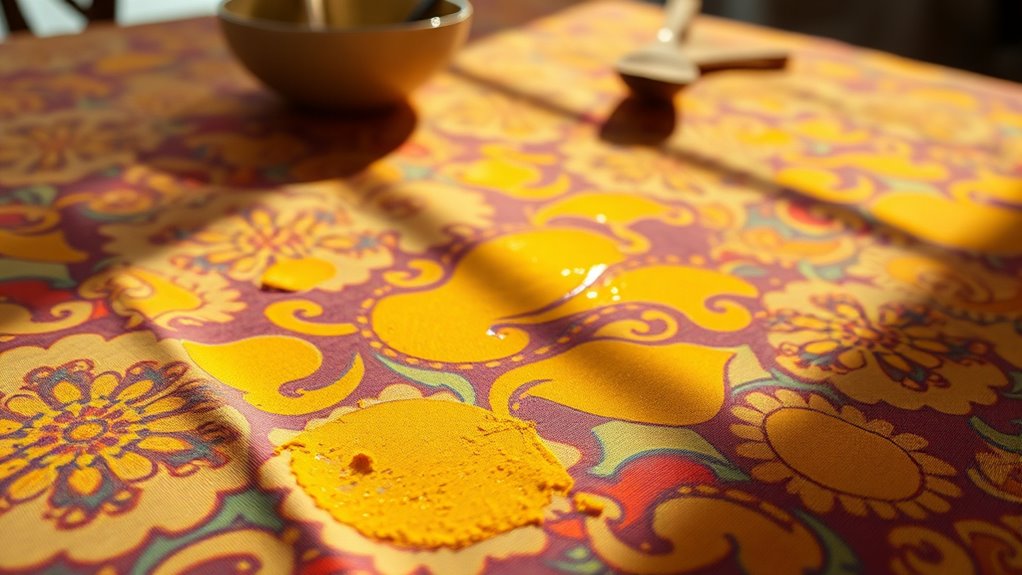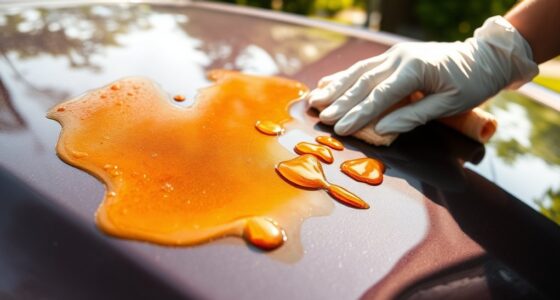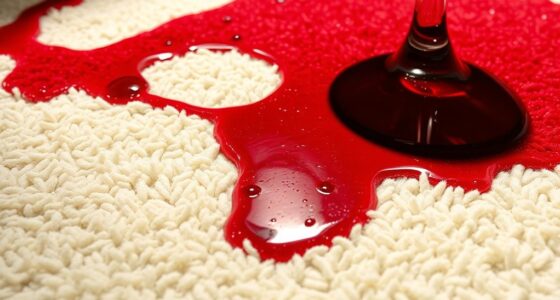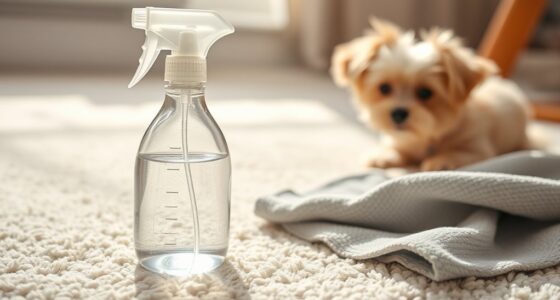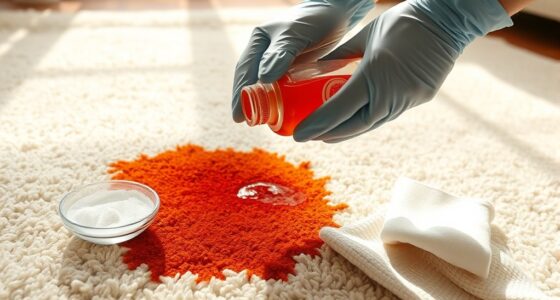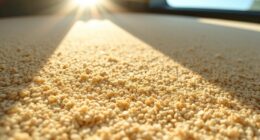Curry stains on your tablecloth? Act quickly! Blot the stain gently with a clean cloth, then rinse it with cold water from the back to push the curry out. Apply liquid laundry detergent directly to the stain and let it sit for at least 30 minutes. For tougher stains, consider using specialized cleaners or natural remedies like vinegar. Don’t worry if the stain persists; there’s more helpful info ahead on effective removal and prevention tips!
Key Takeaways
- Act quickly by blotting the stain gently with a clean cloth and avoid rubbing to prevent spreading.
- Rinse the stain with cold water from the back to push out curry particles before applying any treatment.
- Use liquid laundry detergent directly on the stain, letting it sit for at least 30 minutes for effective removal.
- Consider specialized stain removers like enzyme-based cleaners or oxygen bleach for tougher stains.
- Regularly maintain your tablecloth by inspecting for stains and cleaning it promptly to prevent buildup.
Immediate Action Required
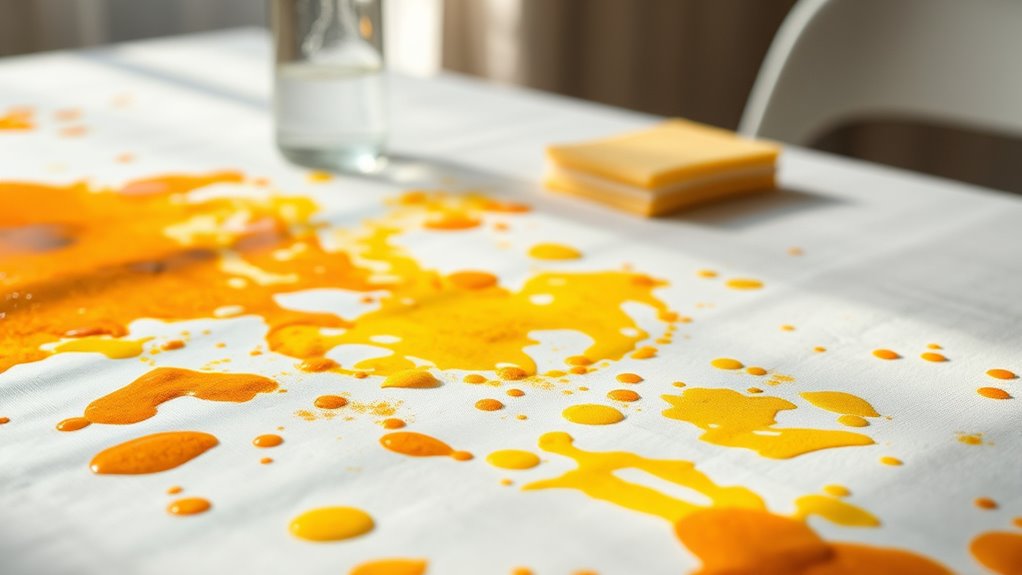
When you spill curry on a tablecloth, you need to act fast to avoid a lasting stain. Speed is essential, so start by gently blotting the stain with a clean cloth or paper towel—don’t rub, as that’ll just spread it. Next, run cold water through the back of the stain to push the curry out of the fabric. If you see any solids, carefully use a dull knife or spoon to remove them, preventing further spreading. Early treatment helps reduce the oily residue that curry can leave behind, so don’t wait. Remember, acting quickly enhances your chances of successful stain removal and keeps your tablecloth looking its best. Pre-treating the stain with laundry detergent or dish soap can significantly improve the outcome.
Pre-treatment for Curry Stains
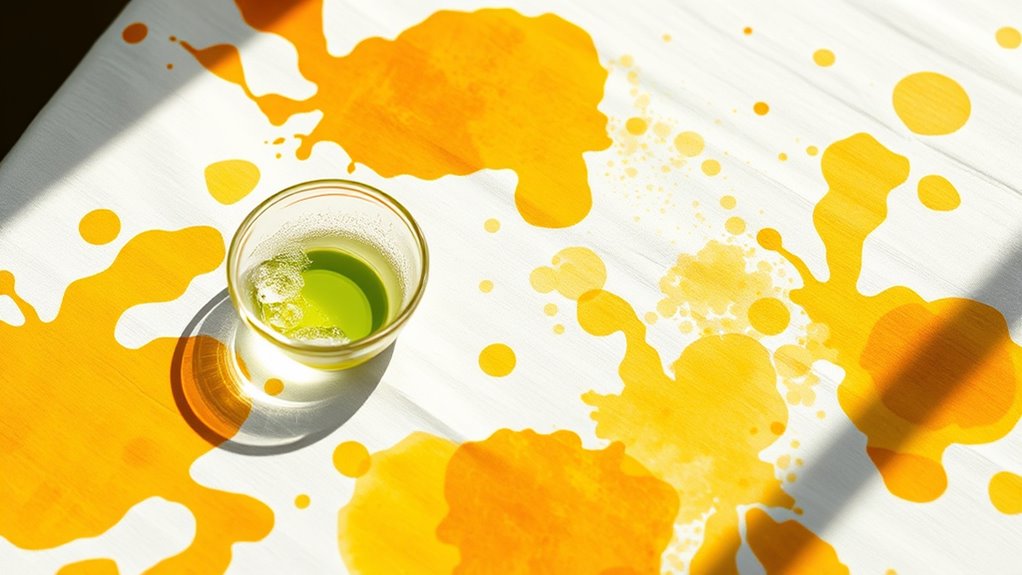
To effectively tackle curry stains, pre-treatment is essential for successful removal.
Start by gently blotting the stain with a clean cloth to absorb excess curry. Rinse the back of the stain with cold water to prevent further penetration, turning the tablecloth inside out if possible. Avoid rubbing, as this can spread the stain.
Gently blot the curry stain and rinse with cold water to minimize damage. Avoid rubbing to prevent spreading.
Next, apply liquid laundry detergent directly to the stain, gently rubbing it in with your fingers or a soft brush. Let it sit for at least 30 minutes. It’s important to remember that curcumin’s lipophilic nature makes curry stains particularly challenging to remove, so prompt action is crucial.
Alternatively, you can mix dish soap with cold water, dab it on the stain, and let it sit for 20-30 minutes.
For a natural remedy, use a vinegar solution or lemon juice, but avoid delicate fabrics.
Specialized Cleaning Solutions
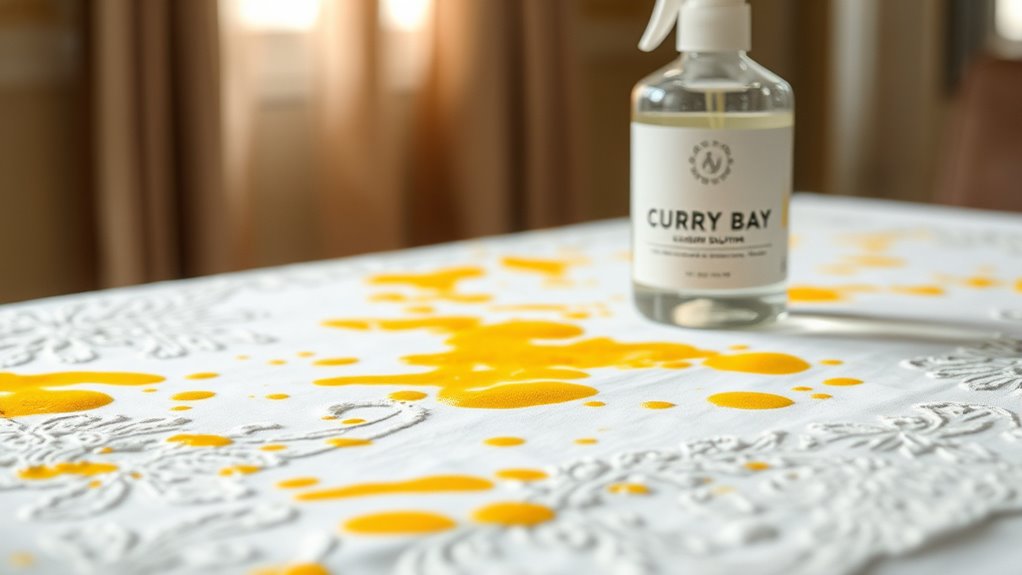
While tackling stubborn curry stains, specialized cleaning solutions can make all the difference in achieving a successful outcome. Enzyme-based cleaners break down the proteins and oils in curry, making them highly effective. Solvent-based cleaners dissolve the stain, simplifying the removal process. For tough stains, oxygen bleach releases oxygen to help break down the mess. Consider stain removers with multiple solvents for better results than single-ingredient options. Laundry detergent boosters can enhance your regular detergent’s stain-fighting power, making them a smart addition. If you’re dealing with synthetic fabrics, look for specialized fabric cleaners or a mild dish soap mixed with cold water. These solutions can help you reclaim your tablecloth and keep it looking fresh. Remember, early treatment is crucial for successfully removing curry stains before they set in.
Natural Stain Removers
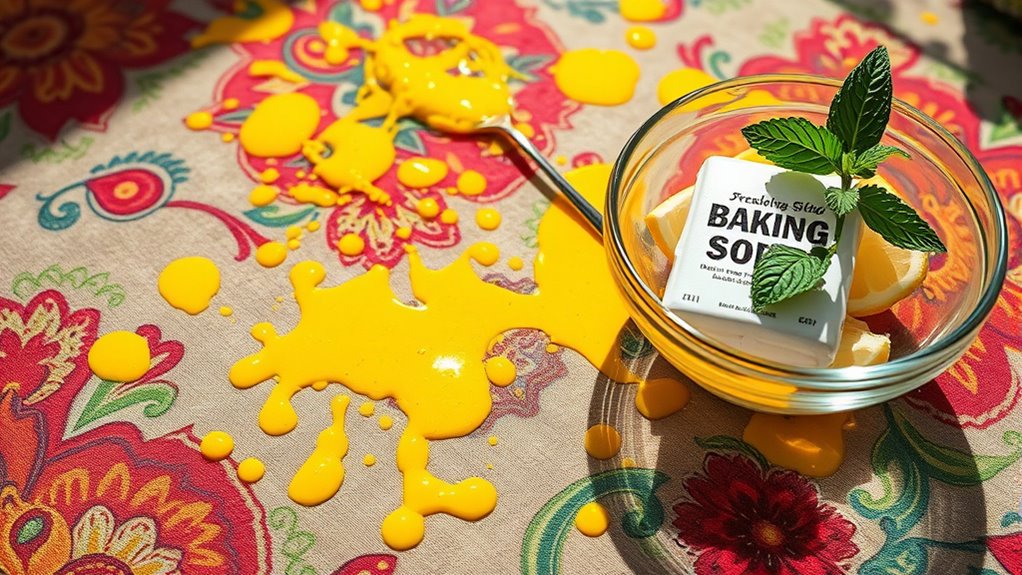
Natural stain removers offer effective solutions for tackling curry stains on your tablecloths without harsh chemicals.
You can start by applying a baking soda paste to absorb the stain, or use a mixture of vinegar and dish soap to cut through the grease.
Lemon juice acts as a natural bleach and can lighten the stain when applied directly. Baking soda is also safe for all fabrics, making it an excellent choice for preserving the quality of your tablecloths.
For oily stains, sprinkle talc or cornstarch over the area to absorb excess oil.
If you need to lift tough stains, try using glycerine or alcohol for spot treatment.
Remember to always test these solutions on inconspicuous areas first, and follow fabric care labels to prevent damage.
With these natural options, you’ll keep your tablecloths looking fresh and clean!
Advanced Stain Removal Techniques
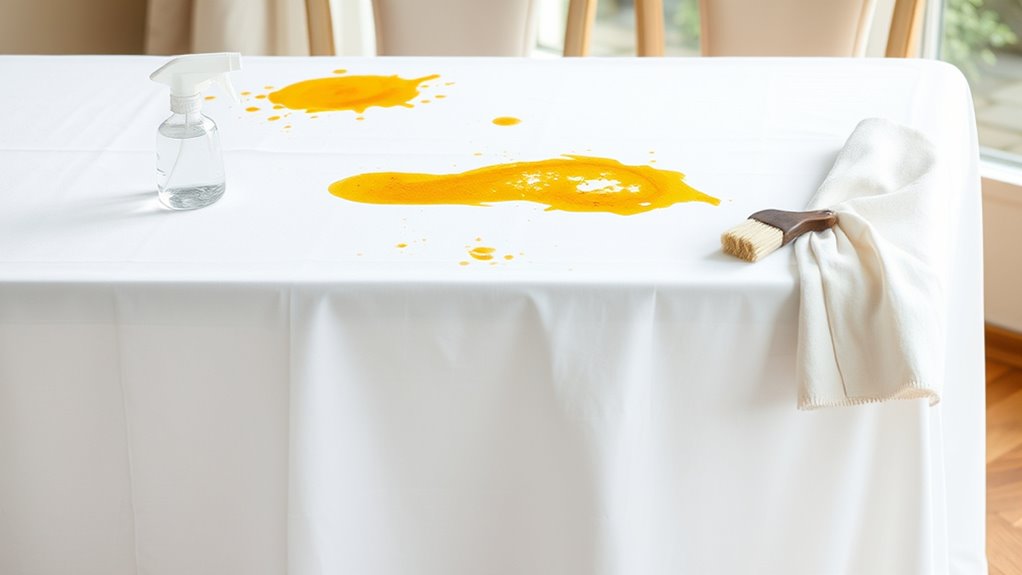
When it comes to tackling stubborn curry stains, understanding advanced stain removal techniques can make all the difference. Start with pre-treatment; apply a liquid detergent directly to the stain to loosen it. For tough cases, consider using an enzymatic pretreater, as these break down the proteins in organic stains. Always test any solution on an inconspicuous area first to avoid damage. Once you’ve treated the stain, use blotting and sponging methods to lift it away. Additionally, frequent checks on your pads and sponges will help maintain their effectiveness. If the stain persists, a paste of baking soda and vinegar can work wonders.
Follow-Up and Maintenance
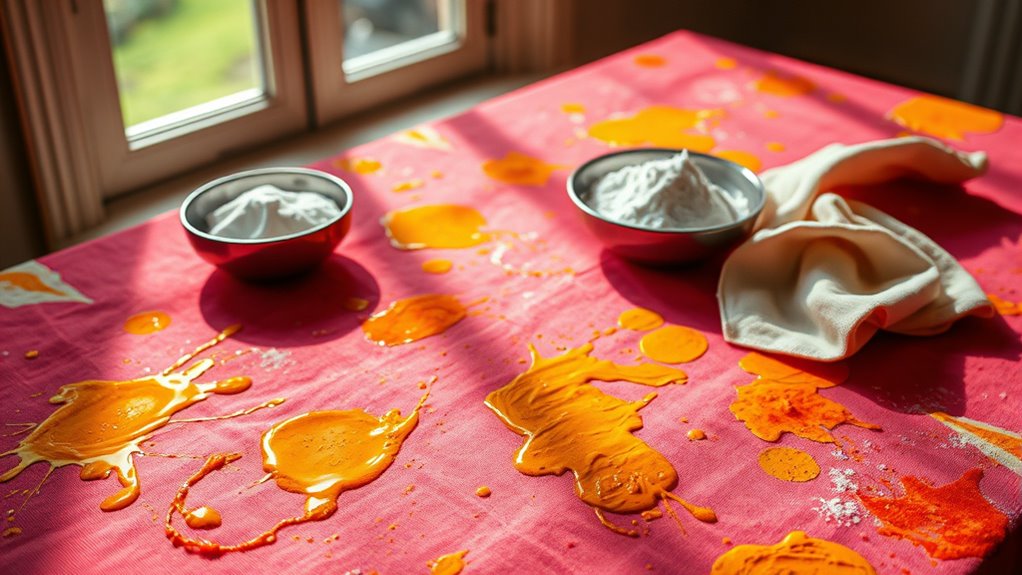
To keep your tablecloth in top condition after removing curry stains, it’s essential to establish a routine for maintenance. Regularly wipe down the tablecloth with a damp cloth to prevent dirt from building up. Make it a habit to inspect for any new or lingering stains. Always guarantee the tablecloth is completely dry to avoid mold and mildew. To maintain its quality, be aware that no wipe clean tablecloth fabric is stain proof and may still require immediate attention after spills. When storing it, choose a dry, well-ventilated area. Avoid harsh chemicals that could damage the fabric, and be mindful of sunlight exposure to prevent fading. Periodically apply stain-resistant treatments and check for any signs of wear. By following these steps, you’ll prolong the life of your tablecloth and keep it looking fresh for many meals to come.
Tips for Preventing Future Stains
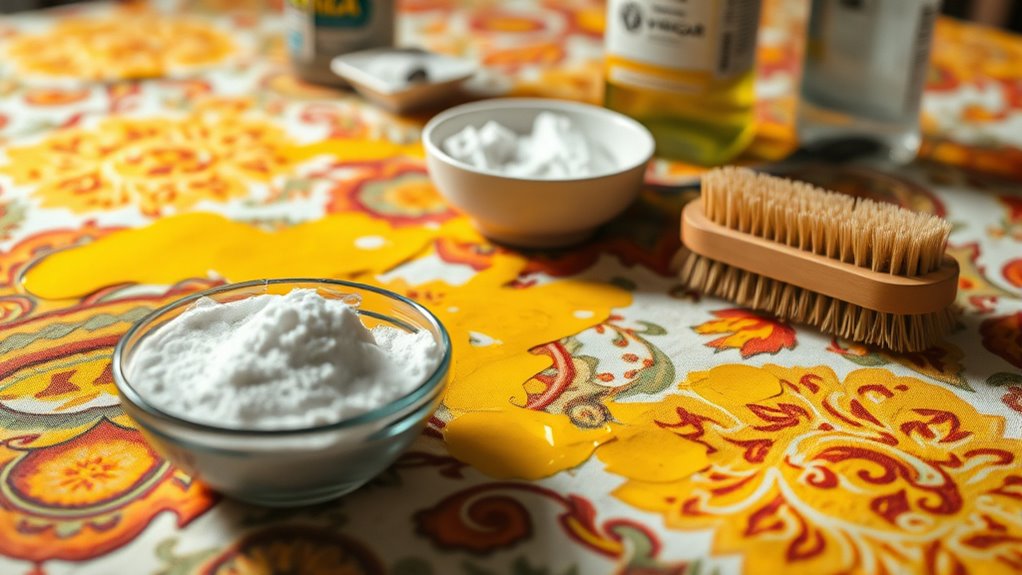
While it’s impossible to eliminate all risks of stains, there are several effective strategies you can implement to protect your tablecloth from future mishaps.
Start by choosing stain-resistant fabrics like polyester or synthetic blends that balance durability and resistance. Use spill mats under dishes to catch any accidents before they reach the tablecloth. Additionally, prompt action is crucial for effective stain removal, so always keep cleaning supplies accessible for quick response. Investing in a best value vacuum cleaner can help maintain your home and keep your tablecloth and surrounding areas clean. Regularly cleaning your tablecloth can also help prevent pollutant reduction by ensuring that dust and allergens do not settle into the fabric. Moreover, incorporating floral arrangements can enhance the aesthetic of your dining area, making it more inviting and reducing the likelihood of careless spills during meals. Remember, maintaining a clean environment can also improve your overall air quality considerations.
Consider applying fabric protectors and regularly applying vinegar or baking soda to maintain stain resistance. Opt for spill-proof containers and stable tableware to minimize spills.
Additionally, using larger tablecloths can help contain messes, while easy-to-clean placemats can catch food spills.
Finally, keep cleaning supplies accessible and have a spill response kit ready for quick action when accidents occur.
Best Practices for Stain Removal
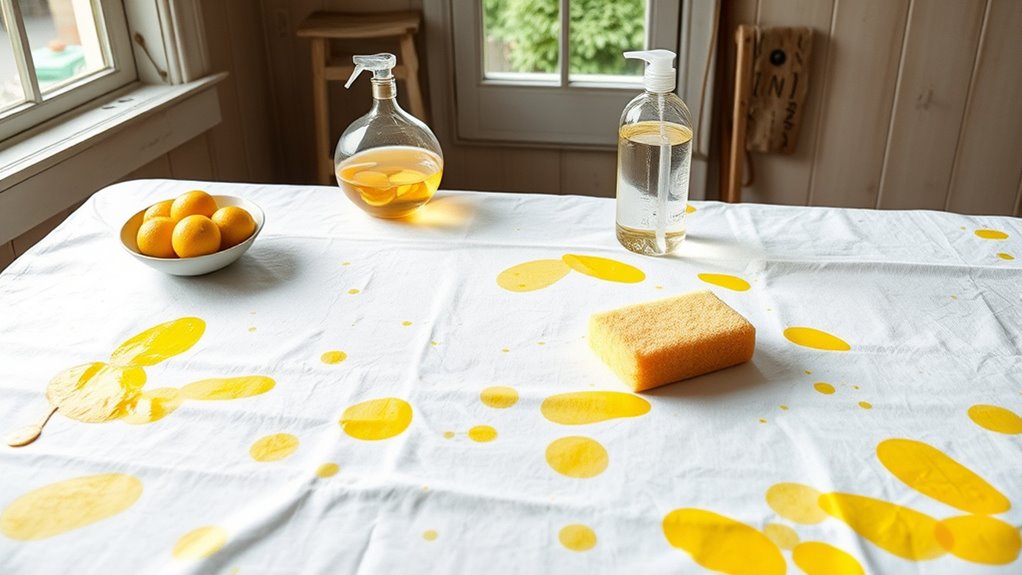
Effective stain removal requires prompt action and the right techniques to prevent permanent damage. Start by blotting excess liquid to stop the stain from penetrating. Rinse the area with cold water to avoid setting the stain. Timely action is essential for effectively lifting the stain and ensuring a successful cleaning process.
Always test any stain remover on a small, hidden fabric section first. Use specialized tools like eyedroppers for precise application. For physical stains, brush dry residues gently with a stiff-bristled brush or scrape carefully if needed.
Pretreat stains with enzyme-based removers for organic stains like curry. Try natural options, like dish soap or lemon juice, for gentle cleaning.
When to Seek Professional Help
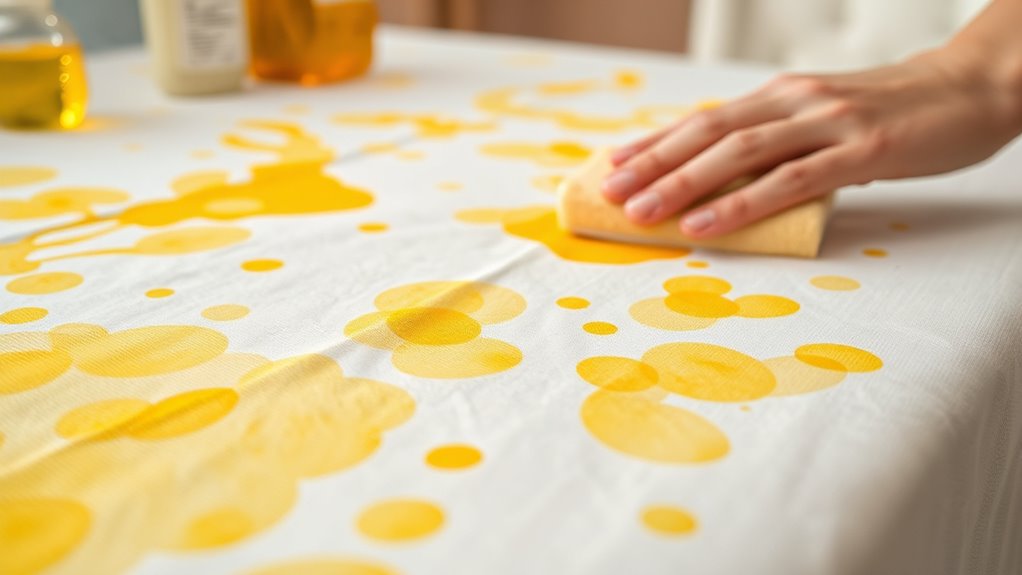
Knowing when to seek professional help can save you time and prevent further damage to your fabrics.
If your tablecloth is made of delicate materials like silk, wool, or vintage fabrics, it’s best to consult an expert for cleaning. Stains that are old or stubborn, especially those that resist home treatments, should prompt you to reach out for professional assistance. Additionally, if you’re working with fabrics that require specific care instructions, similar to evaluating AI model performance in repository name, professional cleaning is essential. Individuals with certain conditions, such as BPD, may find it particularly challenging to manage stain removal due to emotional dysregulation. If oxygen bleach or specialized stain removers fail, don’t hesitate to call in the pros. Remember that stains on eco-friendly materials, which are becoming increasingly popular due to sustainable fashion, may also require specialized cleaning techniques. Regular professional cleaning services can help maintain the integrity of fabrics, reducing the risk of breast cancer associated with certain chemicals found in DIY cleaning products.
Storing Your Tablecloth Properly
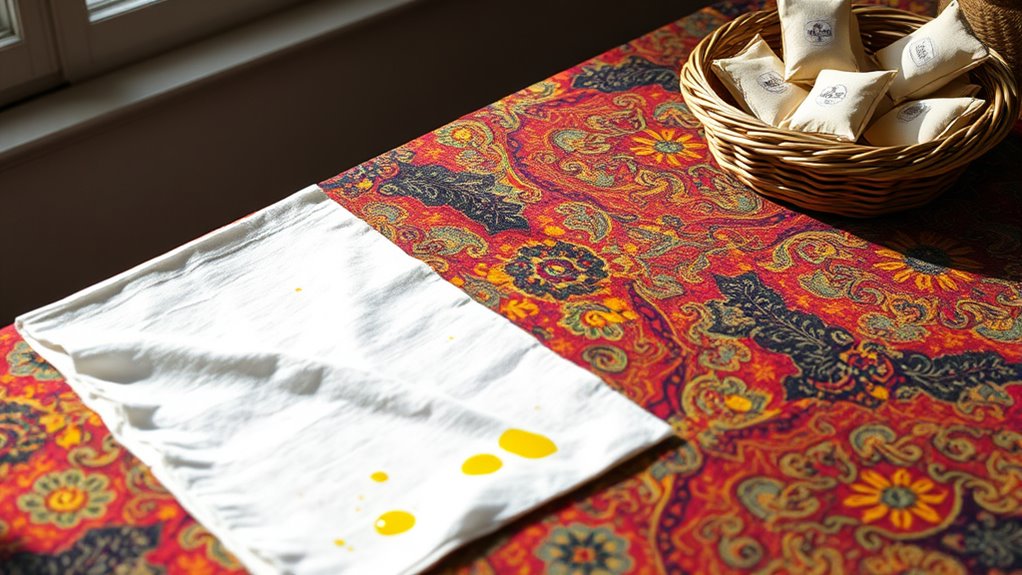
To keep your tablecloths in pristine condition, proper storage is essential. Start by cleaning and thoroughly drying them to prevent mildew.
Choose your storage method: hang larger or delicate fabrics on padded hangers, roll them tightly to minimize wrinkles, or fold smaller ones precisely.
For protection, consider using storage bags or containers to shield from dust and light. Store them in a cool, dry place like closets or under-bed storage, using vacuum seal bags for space-saving.
Maintain organization with dividers in drawers or stack lightly on shelves. Always verify your storage environment is free from moisture and pests, and use acid-free materials to prevent discoloration. This way, your tablecloths remain ready for any occasion.
Additionally, ensure tablecloths are stored in a dry space to prevent moisture-related issues.
Frequently Asked Questions
Can Curry Stains Be Removed From All Types of Fabric?
Curry stains can’t be removed from all types of fabric.
While washable fabrics like cotton and linen respond well to treatment, delicate and colored fabrics need gentle care to avoid damage.
Oilskin and certain synthetic fabrics might require different approaches, and some stains may remain permanent due to turmeric’s strong pigmentation.
You’ll want to act quickly and test any cleaning solutions beforehand to avoid further complications.
Always consider the fabric type before attempting removal.
What if My Tablecloth Is Dry-Clean Only?
If your tablecloth is labeled “dry clean only,” it’s best to avoid DIY methods.
You don’t want to risk damaging the fabric. Instead, gently scrape off any excess curry and immediately take it to a professional cleaner.
They’ll have the right tools and expertise to treat the stain without harming the material.
Always mention the stain type to make sure they use the appropriate cleaning methods for best results.
How Can I Remove Curry Stains From Upholstery?
To remove curry stains from upholstery, start by scraping off any excess with a blunt knife.
Blot the stain with a clean cloth to absorb as much liquid as possible.
Mix dish soap and vinegar, then gently apply it with a sponge, blotting continuously.
Rinse with cool water and let it air dry.
If the stain persists, consider using specialized upholstery cleaners or consult a professional for delicate fabrics.
Will Heat Setting a Stain Make It Permanent?
Yes, heat setting a stain can make it permanent.
When you apply heat, like from a dryer or an iron, it can cause proteins in the stain to bind to the fabric, making them much harder to remove.
If you haven’t treated the stain properly before applying heat, it’s likely to stay.
Always address stains promptly and use cold water initially to prevent them from setting in your fabric.
Are There Any Home Remedies for Curry Stains?
When curry spills like a sunset on your fabric, don’t fret! You can tackle those stains with home remedies.
Mix baking soda with water for a paste, or combine vinegar and water to break down curcumin. Lemon juice works wonders too!
Blot gently, then rinse with cool water. Remember, acting fast is key—don’t let that stain settle in for a permanent stay!
With patience, your fabric can shine bright again.
Conclusion
So, next time you find yourself with a curry-stained tablecloth, remember: you’re not just battling a stubborn stain; you’re fighting against the very fabric of your dinner party’s success. With these tips, you can either become a stain-removing superhero or embrace your new “curry chic” aesthetic. After all, who needs a pristine tablecloth when you can have a conversation starter? Just keep a bottle of stain remover handy, and let the stains tell your dinner’s wild story!
